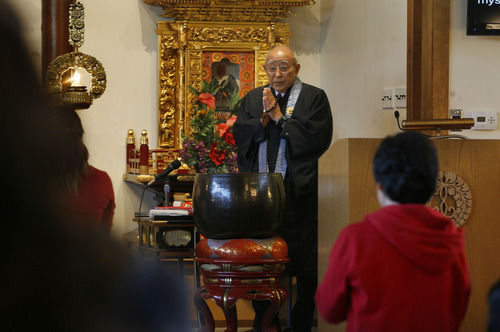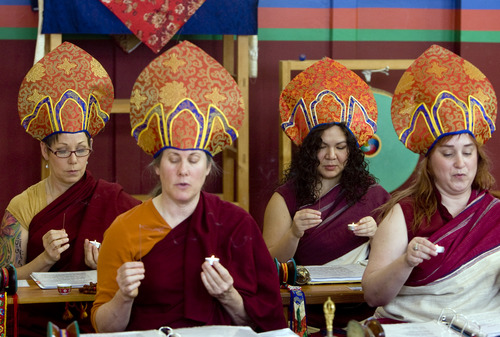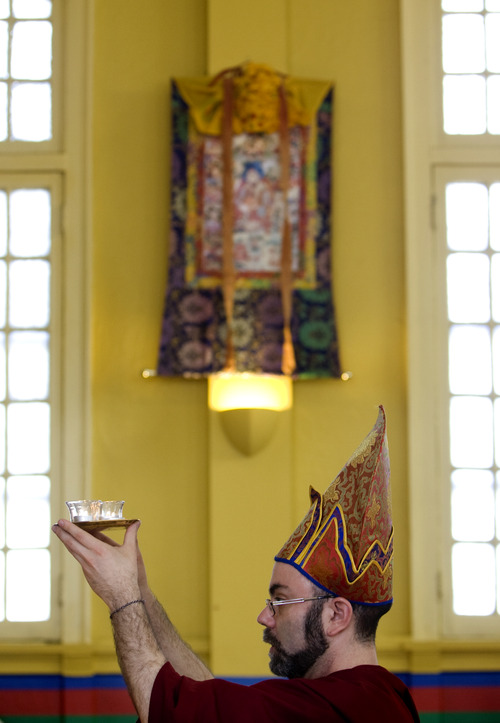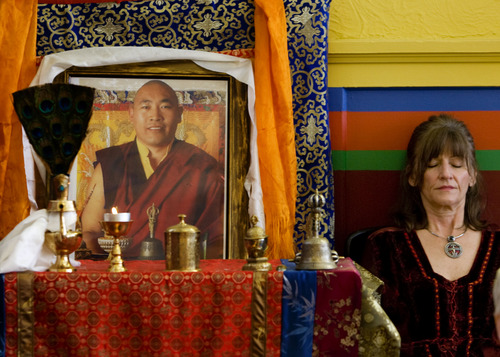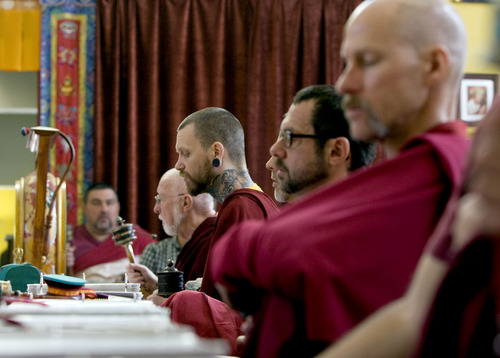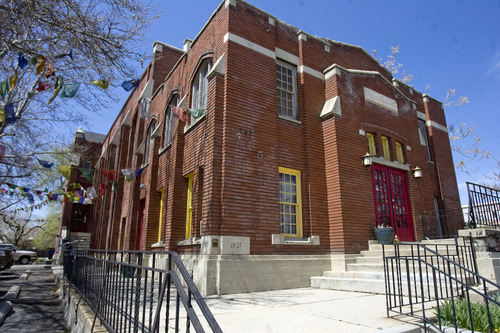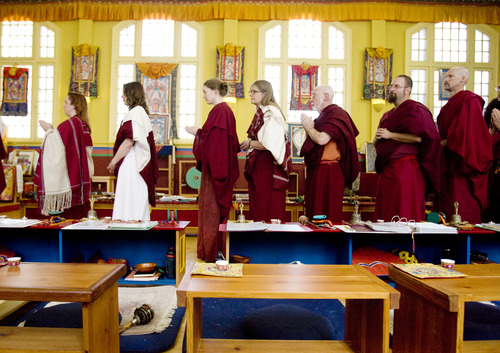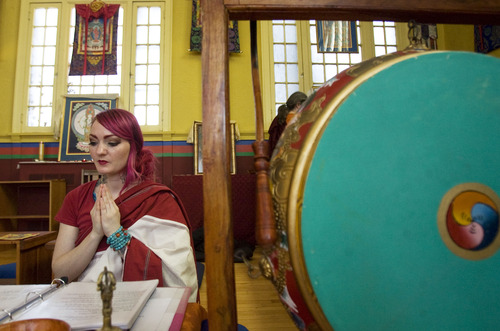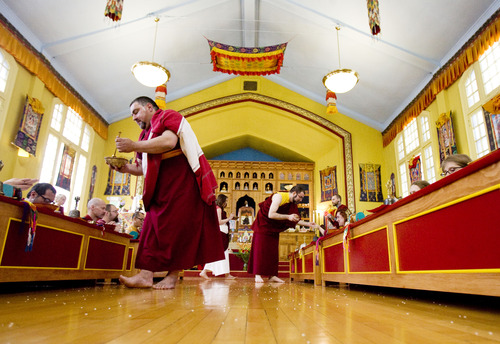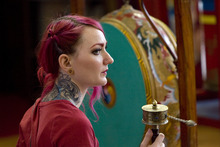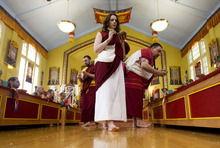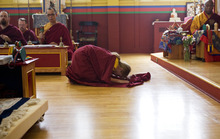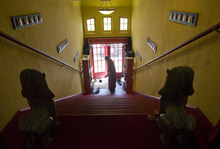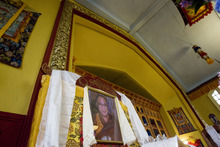This is an archived article that was published on sltrib.com in 2013, and information in the article may be outdated. It is provided only for personal research purposes and may not be reprinted.
Two Buddhist temples dot Salt Lake City's urban core. Both are housed in historic structures, serve a diverse population and preach about the transitory nature of human life.
One of these temples, though, is simple and understated, while the other is ornate and awash in traditional Asian colors. And the details of their sacred spaces reflect very different — even opposite — historical trajectories.
The Salt Lake Buddhist Temple, home to Utah's oldest and most continuous Buddhist congregation, is nestled into a crowded city block near the Calvin L. Rampton Salt Palace Convention Center. The building sits unobtrusively in an area now noted for parking lots and industrial spaces but was once a bustling neighborhood known as Japan Town.
This temple has the look and feel of a Protestant church, and that is no accident, says longtime member Brenda Koga. It was meant to blend in with the country's predominant Christian culture.
"Our particular temple doesn't resemble a Jodo Shinshu temple in other American cities or in Japan," she says. "It's more Americanized architecture."
Across town on 300 West and 700 South, the Urgyen Samten Ling Gonpa is in a century-old Mormon meetinghouse, which has been remade into a traditional Tibetan Buddhist place of worship.
The red, green, white, orange and blue prayer flags and wall hangings, along with the giant wooden shrine bedecked with rows of gold-encased Buddha statues and ablaze with candles, make it tough to imagine the space began as anything but a Buddhist temple. Then there are the yellow walls.
"You can't believe how many versions of mustard yellow there are," quips Jean LaSarre Gardner, a co-founder of the sangha or congregation. "We sent pictures and would call our teacher in Nepal about the color."
When the leader arrived to see the finished space, she says, "he was very pleased."
Old and new, converts and lifelong believers, past and present — all these Buddhists and their buildings add flavor and dimension to Utah's religious scene.
—
Coming to America • Japanese Buddhism arrived in the Mormon heartland more than 100 years ago with migrant workers who took jobs with Utah mines, farms and railroads.
By 1912, these Buddhists created their first congregation in Ogden, known as the Intermountain Buddhist Church. A few years later, the group moved to Salt Lake City, where members practiced Jodo Shinshu, a sect of Buddhism.
Through the years, more immigrants arrived — during World War II, for example, many Japanese Americans were sent to the Topaz internment camp in west-central Utah — bringing their faith and family shrines with them.
When the Salt Lake Buddhist Temple was built in the 1960s, these Buddhists "wanted to prove they were Americanized," Koga says. "They almost overdid it — but it's understandable."
The chapel — or hondo — features pews, pulpit and layout that are more like Protestant churches than their counterparts in Japan.
"The chapel area is supposed to be wider than long because the horizontal line is more soothing than a vertical line," she says. "Our particular chapel does not comply with that whole concept."
It does, however, feature three traditional Jodo Shinshu shrines, elements of design seen in all the sect's temples.
In the middle is the "Amida Buddha," she says, the embodiment of Buddha's teachings. To the right is Shinran Shonin, the founder of the sect, and to the left is Rennyo Shonin, the founder's eighth descendant who formulated the sect's organizational structure.
One of the temple's noteworthy features is a room behind the altar, where the ashes of members are stored.
"We didn't have this space until the temple's remodel in 2010," Koga says, "when it was designed and designated for this purpose."
Now it's like "a library of urns," she says, "where families can go and pay tribute and remember their loved ones."
The towering altar stands at the center of temple worship, but it is not like any found in a Protestant church. This one is covered in gold leaf (symbolizing purity), flowers (representing the impermanence of mortal life) and candles (exemplifying enlightenment).
Though simple, the sanctuary provides spiritual solace, Koga says, for the ever-expanding community of Buddhists.
—
Looking to the ancients • The stately brick temple on 300 West was home to the LDS Fifth Ward, one of Salt Lake City's original 19 Mormon congregations designated geographically, according to Utah architectural historian Jonathan Kland.
Its elaborate design showcased "the Tudor Gothic style, with Tudor window bays distinguished with corbeled arches," reads the National Register of Historic Places description. The gable façades were "decorated with bands of white brick alternating with bands of red. There are concrete-capped buttresses at the corners of the building, as well as between the window bays, and the deeply recessed windows feature thick mullions and splayed casings. Overall, the church is a two-story T-shaped plan with shallow, pitched gable roofs."
Latter-day Saints danced and played and worshipped in the space for decades, creating one of the first welfare farms to grow food during the Depression. In 1952, the chapel was the temporary home to 20 Mormon families displaced by flood; five of them stayed for more than a month.
At first, the membership "had a strong European immigrant flavor, that was gradually being combined with Hispanic-American," Kland writes in his Fifth Ward history. "In the few years prior to the decision to sell the structures, the Fifth Ward became the Lamanite Ward to serve the needs of Salt Lake City's urban Indian population."
By 1975, the ward moved elsewhere, vacating the building. Three years later, the building was listed on the National Register of Historic Places, after which it had a parade of tenants — a photography studio, a real-estate and investment firm, and Debbie's Escort Services, to name a few. Then came the clubs — Club Fusion, Club Vesuvius and Sanctuary, which specialized in dark spaces and industrial lights.
When Urgyen Samten Ling's leaders bought the building in May 2004, volunteers had to strip black and silver paint from the windows, pull up alcohol-drenched carpet, refinish the wood floors and repaint every square inch.
They also wanted a real shrine, rather than the makeshift one they had in their previous, smaller Salt Lake City location at 345 W. Pierpont Ave.
"We met a gentleman from Tibet who had come to Utah to join his family," recalls Gardner. "Kalsang Diwatsang was a master carpenter in Tibet and Nepal, specializing in shrines for Buddhist temples."
Diwatsang didn't speak English and the Gardners didn't speak Tibetan, but via hand signals and sketches on napkins, the two groups were able to craft a plan.
With the donated gifts and efforts of students, practitioners, neighbors and helpers, the Buddhists transformed what was once a community center for pioneering Mormon immigrants into a soothing space for chanting and meditation — all within three months.
It became once again "a place of spiritual practice," Gardner says. The Mormons seem "happy it is no longer a nightclub."
Facebook.com/peggy.fletcherstack
Twitter: @religiongal —
'Where We Worship' series
Once a month throughout 2013, The Salt Lake Tribune is featuring Utah's sacred spaces — whether mighty cathedrals or modest meetinghouses.
Today • Two Salt Lake City Buddhist temples
About the Urgyen Samten Ling Gonpa [Tibetan Buddhist Temple]
Location • 740 S. 300 West
Built • 1910, as the Salt Lake LDS Fifth Ward
Interior Rebuilt • May to August 2004
Features • Red brick exterior in Tudor Gothic style, interior is painted Tibetan colors, with a blue ceiling asnd showcasing a hand-carved wood shrine.
—
About the Salt Lake Buddhist Temple
Location • 211 W. 100 South
Built • 1961
Interior Remodel • 2010
Features • Wood pews and pulpit, with a golden altar and a "library of urns." —
Japan Festival
What •Salt Lake Buddhist Temple's Japan Festival, featuring Hawaiian dancers, a Kimono fashion show, tea ceremony, martial arts, drummers, exhibits and food.
When • Saturday, April 27, 10 a.m. to 5 p.m.
Where • 100 South between 200 West and 300 West
Cost • Free —
Japan Festival
What • Salt Lake Buddhist Temple's Japan Festival, featuring Hawaiian dancers, a Kimono fashion show, tea ceremony, martial arts, drummers, exhibits and food.
When • Saturday, April 27, 10 a.m. to 5 p.m.
Where • 100 South between 200 West and 300 West
Cost • Free


